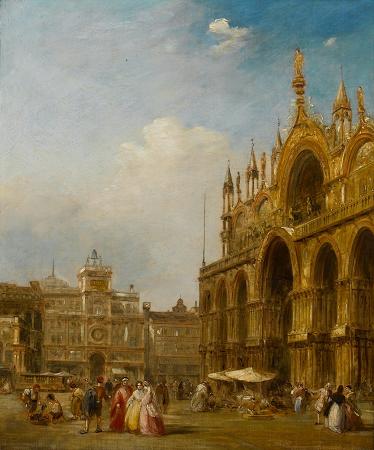Saint Mark's Basilica (c830). The Patriarchal Cathedral Basilica of Saint Mark, commonly known as St Mark's Basilica, is the cathedral church of the Roman Catholic Archdiocese of Venice, northern Italy. It is the most famous of the city's churches and one of the best known examples of Italo-Byzantine architecture. It lies at the eastern end of the Piazza San Marco, adjacent and connected to the Doge's Palace. Originally it was the chapel of the Doge, and has been the city's cathedral only since 1807, when it became the seat of the Patriarch of Venice, archbishop of the Roman Catholic Archdiocese of Venice, formerly at San Pietro di Castello. The building's structure dates back to the latter part of the 11th century. Much work has gone toward embellishing this, and the famous main fašade has an ornamented roofline that is mostly Gothic. The gold ground mosaics that now cover almost all the upper areas of the interior took centuries to complete. In the 13th century the external height of the domes was greatly increased by hollow drums raised on a wooden framework and covered with metal; the original ones are shallower, as can be seen on the inside. This change makes the domes visible from the piazza. For its opulent design, gold ground mosaics, and its status as a symbol of Venetian wealth and power, from the 11th century on the building has been known by the nickname Chiesa d'Oro. It achieves an Oriental feeling of exoticism, has all the elements of the Venetian style of the Renaissance Art, remains unique, and essentially a product of Italian workers of all sorts. The first St Mark's was a building next to the Doge's Palace, ordered by the doge in 828. With a profusion of domes and more than 8000 sq metres of luminous mosaics, Venice's cathedral is unforgettable. It was founded in the 9th century to house the corpse of St Mark after wily Venetian merchants smuggled it out of Egypt in a barrel of pork fat. When the original building burnt down, Venice rebuilt the basilica in its own cosmopolitan image St Mark's Campanile. The church was burned in a rebellion in 976, when the populace locked Pietro IV Candiano inside to kill him, and restored or rebuilt in 978. Nothing certain is known of the form of these early churches. From perhaps 1063 the present basilica was constructed. The consecration is variously recorded as being in 1084-85, 1093, 1102 and 1117, probably reflecting a series of consecrations of different parts. The size of the church was increased in all directions, especially to the north and south, and the wooden domes replaced by brick, which required thickening such walls as were retained. In 1094 the body considered traditionally to be that of Saint Mark was rediscovered in a pillar by Vitale Faliero, doge at the time. The building also incorporates a low tower, believed by some to have been part of the original Doge's Palace. The Pala d'Oro ordered from Constantinople was installed on the high altar in 1105. In 1106 the church, and especially its mosaics, were damaged by a serious fire in that part of the city; it is not entirely clear whether any surviving mosaics in the interior predate this, though there is some 11th-century work surviving in the main porch. The main features of the present structure were all in place by then, except for the narthex or porch, and the facade. The basic shape of the church has a mixture of Italian and Byzantine features, notably the treatment of the eastern arm as the termination of a basilican building with main apse and two side chapels rather than as an equal arm of a truly centralized structure. In the first half of the 13th century the narthex and the new facade were constructed, most of the mosaics were completed and the domes were covered with second much higher domes of lead-covered wood in order to blend in with the Gothic architecture of the redesigned Doge's Palace. As with most Venetian buildings, the main structure is built in brick, with the arches given moulded terracotta or brick decoration, with stone columns, capitals, horizontal mouldings, and some other details. The brick mostly remains in place, but covered over except in a few places. The basic structure of the building has not been much altered. Its decoration has changed greatly over time, though the overall impression of the interior with a dazzling display of gold ground mosaics on all ceilings and upper walls remains the same. The original unadorned structure would probably have looked very different, but it is likely that gradual decoration was always intended.
more...






